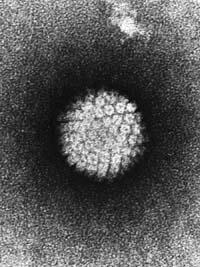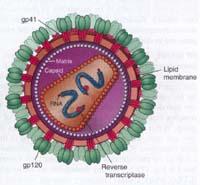Novel of Physiology or Medicine for those who discovered human papilomabirus and AIDS
2008/10/06 Galarraga Aiestaran, Ana - Elhuyar Zientzia
Human papilomabirus, causing uterine cancer
Harald zur Hausen works at the Cancer Center in Germany and, in the 1970s, opposed the central idea of medicine at the time, proposing that cervical cancer was caused by a virus. However, he was not the only one who thought that in the genesis of this cancer viruses could participate, since others also considered it, but believed it was a herpes virus.

Human papilloma virus by electronic microscope.
Photo: United States Institute of Health
Harald zur Hausen also began to investigate with this hypothesis. However, in cancer cells in the cervix there was no herpes virus and proposed another virus, the human papilloma. I thought that if this virus infected cells and turned them into cancer cells, I would find the genome of the virus in the DNA of cancer cells. So, he spent about ten years searching for the genome of the virus in cancer cells.
It was not an easy task, as only a part of the human papillomavirus genome integrates into cellular DNA, not entirely. However, he identified himself and realized that there were several types: some produce cancer and others do not. It differentiated between each other and demonstrated what gives the former the ability to cause cancer.
Thanks to the work done by Harald zur Hausen, much progress has been made in the detection and prevention of cervical cancer. For example, currently there are vaccines that protect from the two most malignant types (genotypes 16 and 18), although they do not agree on the convenience or not to perform vaccinations, since they do not know the extent of immunity and fear that cancers generated by other types increase.
HIV, the cause of AIDS

HIV structure.
Image courtesy of: Nobel Foundation
In 1981 a new disease was described in California and New York. They called him AIDS and soon realized that it was expanding rapidly. For various characteristics (groups of patients, lymphocyte loss, blood transmission) it was suspected that the agent had to have a retrovirus, and some groups of researchers were looking for it.
In 1983 they began to study the lymphocytes removed from the patients Françoise Barré-Sinoussi and Luc Montaigner, elaborated cultures and searched for remnants of the retrovirus. Cultured lymphocytes saw a reverse transcriptase, an enzyme that uses retroviruses to reproduce. They also demonstrated that cultural lymphocytes released virus particles that contaminated healthy lymphocytes. This virus was isolated and known as LAV (associated lymphadenopathy virus or lymphadenopathy related virus). Then the AIDS virus was associated and it was called HIV, the human immunodeficiency virus.
Thanks to the work of researchers Françoise Barré-Sinoussi and Luc Montaigner, many groups of researchers began to investigate how it infects the virus itself, how it infects the organism, what immune response it causes and what can be done to cure and prevent it. Despite progress in all these fields, there is still no vaccine to protect from infection, and researchers recognize that they do not yet know the influence of the virus on the immune system to get an effective vaccine.
The virus has developed a number of mechanisms to escape the immune system. Among other things, glycosylation of the outer layer glycoprotein protects the neutralization epitopes and infected cells are definitely infected, even when they die. In addition, the reproductive machine does not have error correction mechanisms, so it mutates much more than any other virus.
On the contrary, treatments have improved significantly in recent years, so patients who are currently able to receive adequate treatment have practically the same life expectancy as healthy people. But treatment is not available to all patients, not even preventive measures. Therefore, although much progress has been made, there is much to do, since the global prevalence of AIDS is 1% and they expect to continue growing.

Gai honi buruzko eduki gehiago
Elhuyarrek garatutako teknologia




